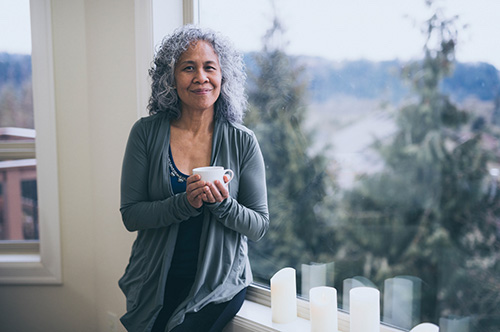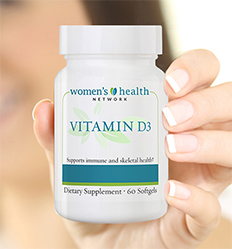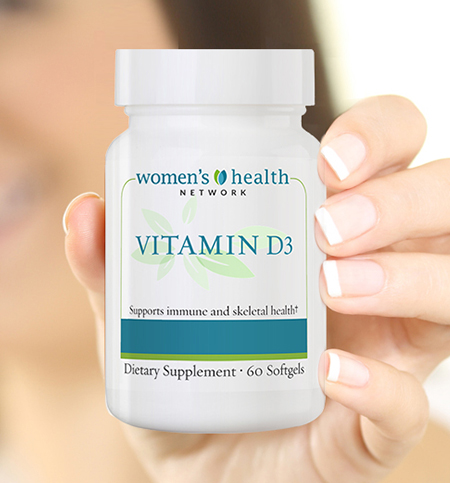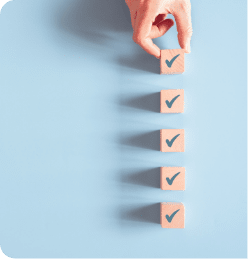Authored by Dr. Sharon Stills, NMD
Is it possible that natural antidepressants could help women more than prescription drugs?
Only 55% of prescription antidepressants are actually given for depression, so natural alternatives are worth considering in many cases. Antidepressant usage has skyrocketed — up 65% over the last 15 years. Surprisingly, women are twice as likely as men to be on antidepressants even without reporting being depressed.

Doctors give women antidepressants for lots of off-label, non-depression reasons such as pain, insomnia, menopause symptoms, migraines, fibromyalgia and more. On top of that, antidepressants have so many side effects that, for many women, the treatment may end up being worse than the problem they’re taking it for.
Depression is a serious and debilitating disorder that can threaten your health by interfering with basic functions such as sleeping and eating. But what works for one woman with depression, may not be the solution for another.
Natural antidepressants may be effective alternatives for many women while prescription medications can lead to good outcomes for others. So, understanding the available options can help you decide what’s right for you.
Can prescription antidepressants fix what’s broken?
Advertisements for antidepressants are sprinkled throughout women’s magazines as well as TV shows showing these drugs leading to happy endings in 60 seconds or less. From Prozac, Paxil and Zoloft to Wellbutrin, Celexa and Lexapro, these prescription drugs are seen as normal medicines that allow women to get back to their families so they can lead productive lives.
Certainly we all want that, right? So why not fill an antidepressant prescription if your doctor offers it?

Antidepressants may help some women, especially those with major depression. But they’re often not effective, and even worse, may lead to a lot of unpleasant side effects. Antidepressants are not the only way to navigate difficult periods in life, because there are natural options for improving mood and outlook.
When you aren’t feeling like yourself and are unsure of which path is right for you, drugs will still be there if you end up deciding to take them.
On the depression spectrum, how depressed are you?
The term depression includes a range of negative emotions such as “situational” and “mild” depression as well as clinical depression, which is a diagnosable disorder. However, the symptoms for all of these can be similar or even the same — at least for a time. With mild depression, symptoms can come and go but they eventually do lift. With major or clinical depression, however, symptoms are severe, spiraling down into a mental health crisis.
Symptoms of depression include:
- overwhelming feelings of grief, anxiety, guilt or despair
- a sense of numbness or hollowness
- a loss of interest or pleasure in activities that used to be enjoyed, including sex
- decreased energy as well as extreme fatigue
- difficulty concentrating or making decisions
- disrupted sleep patterns
- overeating and weight gain or loss of appetite and weight loss
Even though there is a wide range when it comes to depression severity, if you’ve had depressive symptoms consistently for over a month, we urge you to contact a medical professional — a psychiatrist, psychologist or social worker. Suicidal thoughts or attempts as well as focusing on death are all serious warning signs that should be addressed immediately. Also, they’re nothing to be ashamed about.
Depression drugs: overprescribed, often ineffective and loaded with side effects
Emotional concerns, including depression, anxiety or mood changes deserve more than the seven minutes most conventional doctors are given to spend with each patient. Consequently, this rush to diagnose and treat may lead to a fast prescription for an antidepressant.
If you are advised to take an antidepressant drug, then it’s a good idea to take some time with this decision. Antidepressant side effects such as restlessness, anxiety, sexual dysfunction, extreme appetite changes, weight changes, panic attacks, drug interactions, sweating and more can be severe.
In terms of effectiveness there’s ongoing debate about whether antidepressants can help people with mild to moderate depression. One meta-analysis revealed minimal or nonexistent benefits when antidepressants are compared to placebo for mildly to moderately depressed people. People with severe depression generally show more substantial benefits.

But antidepressants may also have longer-lasting side effects. They can alter the biochemistry of the brain, and cause real problems when you try to stop taking them. Sometimes while “tapering down” their antidepressants, people have disruptions in sleep and digestion, and develop neurological symptoms like tics, tingling and scary “zapping” sensations in their brains.
A serious aftereffect known as serotonin syndrome can arise when there is excess serotonin-related activity in the nervous system. Though rare, this issue has grown more common and is often misdiagnosed.
What’s causing your depression?
Many forms of depression are natural and normal as well as temporary. Some researchers even believe they can help you work through a problem like a fever fights off infection. Many events can lead to feeling depressed such as death of a loved one, a health crisis, financial problems, divorce and break-ups, and employment challenges. Even events that seem positive such as moving, weddings and births can lead to depression.
Women with postpartum depression, seasonal affective disorder, anxiety and situational depression can be reluctant to seek help because they feel embarrassed that they can’t “control” their emotions. But antidepressants are not always the answer.
Often, depression is the result of a combination of factors. If you can uncover those root causes, then you may start to feel better without having to take an antidepressant. Past experiences in particular can influence your biochemistry, causing you to be more susceptible to depression. Even though it’s nothing you can change, what happened in your early childhood — or even in utero — may create a heavier burden for you later in life.
Research has shown that thoughts can have a long-lasting physical effect in the body, and vice versa. Mild or moderate depression can possibly become an opportunity to generate needed change, though that is easier said than done. There can also be real physiological factors contributing to your depression. Maybe your diet or sleep patterns are off. However, you could be reacting to toxicity in your environment. For example, certain forms of mold can cause some people to be depressed.
Being able to step back and also take a close look at your health can begin to decode the causes of your depression.
Serotonin and other components of brain chemistry
The neurotransmitter serotonin plays a role in depression but it can be affected by different things in different people. For example, women with intense carb cravings often feel better after eating them. That’s because the precursor to serotonin, tryptophan, needs the insulin produced when we eat carbs to move it into the brain to be converted to serotonin.

Some women’s bodies release more or less beta-endorphin, another feel-good neurotransmitter, after they eat sweets or refined carbohydrates. But when women come down from a sugar high, they feel even lower, with more intense cravings. They also feel worse off because of the extra weight and guilt that can go along with this cyclical pattern.
Brain chemistry is also affected powerfully by stress which can increase cortisol production. Over time, the stress scenario can also lead to depression. Hormone expert Bethany Hays, MD, explains the pathway like this:
High adrenaline ⇒ Anxiety ⇒ High Cortisol ⇒ Anxious Depression ⇒ Depression
Production of the stress hormones adrenaline and cortisol through the hypothalamic-pituitary-adrenal (HPA) axis wins out over other hormonal pathways, this then upsets balance everywhere else. Restoring balance begins with figuring out how to reduce stress as well as anxiety in your life.
Hormones, Vitamin D levels, diet and exercise affect emotional health
Women are especially vulnerable when hormones are in major flux — the days before menstrual periods, during pregnancy and right after, and in perimenopause. However, some women respond well to bioidentical progesterone or phytotherapy.
Research shows that Vitamin D supplementation can help patients with seasonal affective disorder, suggesting a connection between Vitamin D and normal neurotransmitter function. Sunlight turns melatonin production off, while triggering the production of Vitamin D. But melatonin influences sleep, cravings and moods.
Nutrition has more of an effect on mood and brain function than you might realize. Everyday nutrients such as B-complex vitamins, vitamins C and D3, and zinc are good fuel for your brain. Omega-3s and the amino acids l-theanine (found in many types of tea) as well as cysteine (found in egg yolks, onions, red peppers and broccoli) support healthy brain function too.
Our brain chemistry is affected by factors such as sleep, digestion and exercise. So the way you think and feel depends on many variables unique to each woman. So you may need to experiment with changes to your daily routine to find the right combination for you.
Even tiny things like taking a walk or eating a healthy salad can seem difficult when you’re depressed. But if you can nudge yourself to make these steps, you might feel a little better. And feeling a little better can change your whole perspective as well as help you make other healthy adjustments.
Natural antidepressant therapies for depression
A combination approach to lifting depression generally offers better symptom resolution and long-term results than any one single thing.
An integrative or alternative health care practitioner can help put together a plan to meet your individual needs. It might include psychiatry, prescription drugs and natural holistic approaches such as these:
- Talk therapy or counseling
- Body work methods, such as craniosacral therapy (CST), osteopathic manipulative therapy (OMT), therapeutic massage
- Acupuncture
- Phytotherapy, such as St. John’s wort, passionflower or valerian
- Targeted amino acid support, such as SAM-e or GABA
- Nutritional supplements such as vitamins, minerals and omega-3 fatty acids
- Full-spectrum light therapy

At-home natural approaches to help relieve depressed feelings
From sunlight to healthy snacking, you can sometimes coax your brain chemistry to be more balanced so your moods are steadier.
If you feel up to it, then try some of these options:
- Eat a low glycemic-load, Mediterranean-style diet with adequate protein as well as lots of plant foods.
- Add a daily supplement regimen, including vitamins, minerals, omega-3s and probiotics.
- Get your Vitamin D level tested and supplement accordingly.
- Go to bed by 10 pm to encourage getting enough sleep.
- Exercise outdoors — yes, regular walking counts.
- Try yoga or meditation.
- Consider talking to your practitioner about alternative therapies such as those described in the section above.
And certainly consider talking to your practitioner about natural and alternative therapies. Having a trusted professional partner to guide you through the process of feeling better can make a difference.
Give yourself an emotional lift — naturally
Of course, your life circumstances can affect your outlook on life. And sometimes we simply don’t take very good care of ourselves, so inadvertently make things worse.
If you can be kind to yourself and have the luxury of time to explore what feels good and right for you, then you might be able to nudge yourself toward feeling better and healthier.
It may be hard to believe now, but much of the time, feeling depressed is most likely a temporary situation. Time can be a great healer. But with help, support and attention to your daily health, you can feel well again in body, mind and spirit.
References and further reading
References
https://www.huffingtonpost.com/entry/reasons-people-are-taking antidepressants_us_57472146e4b03ede441411a6
https://www.webmd.com/depression/news/20170815/us-antidepressant-use-jumps-65-percent-in-15-years#1
Lena Thunander Sundbom, Kerstin Bingefors, Kerstin Hedborg, and Dag Isacson. Are men under-treated and women over-treated with antidepressants? Findings from a cross-sectional survey in Sweden. BJPsych Bull. 2017 Jun; 41(3): 145–150. https://www.ncbi.nlm.nih.gov/pmc/articles/PMC5451647/ Accessed 9.18.18.
https://www.nimh.nih.gov/health/topics/depression/index.shtml
https://www.webmd.com/vitamins/ai/ingredientmono-1053/theanine
https://www.livestrong.com/article/256383-what-is-cysteine
Mojtabai, R. 2008. Increase in antidepressant medication in the US adult population between 1990 and 2003. Psychother. Psychosom., 77 (2), 83–92 URL: https://content.karger.com/produktedb/produkte.asp?typ=fulltext&file=000112885 (accessed 03.22.2010).
Barber, C. 2008. The medicated Americans: Antidepressant prescriptions on the rise. Scientific American. URL: https://www.scientificamerican.com/article.cfm?id=the-medicated-americans (accessed 04.08.2010).
MacReddy, N. 2007. Antidepressant metabolite for menopause symptoms. URL: https://www.medscape.com/viewarticle/556290 (accessed 04.08.2010).
Beasley, D. 2007. Wyeth’s Pristiq helps menopause hot flashes —trials. URL: https://www.reuters.com/article/idUSN0136556020070508 (accessed 04.08.2010).
Warner Chilcott. [No date of publication listed.] Sarafem. URL: https://www.wcrx.com/products/sarafem.jsp (accessed 04.08.2010).
Lacasse, J., & Leo, J. 2005. Serotonin and depression: A disconnect between the advertisements and the scientific literature. PLoS Med., 2 (12), e392. URL: https://www.plosmedicine.org/article/info%3Adoi%2F10.1371%2Fjournal.pmed.0020392 (accessed 04.08.2010).
[No author listed.] 2005. Ads for SSRI antidepressants are misleading, say researchers. Medical News Today. URL: https://www.medicalnewstoday.com/articles/33290.php (accessed 04.08.2010).
Morgan, A., & Jorm, A. 2008. Self-help interventions for depressive disorders and depressive symptoms: A systematic review. Ann. Gen. Psychiatry, 7, 13, URL: https://www.annals-general-psychiatry.com/content/7/1/13 (accessed 04.08.2010).
[No author listed]. 2009. New data shows overreliance on antidepressants, says Mental Health Foundation. URL: https://www.mentalhealth.org.uk/media/news-releases/news-releases-2009/21-april-2009/ (accessed 04.08.2010).
Jones, N. 2008. Antidepressants “no better than placebo.” The Great Beyond. URL: https://blogs.nature.com/news/thegreatbeyond/2008/02/post_3.html (accessed 04.08.2010).
Moncrieff, J., et al. 2004. Active placebos versus antidepressant for depression. Cochrane Database Syst. Rev., 1, CD003012. URL: https://www.ncbi.nlm.nih.gov/pubmed/14974002 (accessed 04.08.2010).
Kirsch, I., et al. 2002. The emperor’s new drugs: An analysis of antidepressant medication data submitted to the U.S. Food and Drug Administration. Prev. Treat., 5, article 23. URL: https://journals.apa.org/prevention/volume5/pre0050023a.html (accessed 04.08.2010).
Kirsch, I., et al. 2002. Antidepressants and placebos: Secrets, revelations, and unanswered questions. Prev. Treat., 5, article 33. URL: https://journals.apa.org/prevention/volume5/pre0050033r.html (accessed 04.08.2010).
Fournier, J., et al. 2010. Antidepressant drug effects and depression severity. JAMA, 303 (1), 47–53. URL: https://jama.ama-assn.org/cgi/content/short/303/1/47?home (accessed 01.16.2010).
[No author listed.] 2006. Some can’t stop antidepressants. URL: https://www.msnbc.msn.com/id/14126142 (accessed 04.08.2010).
Attar–Herzberg, D., et al. 2009. The serotonin syndrome: Initial misdiagnosis. Isr. Med. Assoc. J., 11 (6), 367–370. URL (abstract): https://www.ima.org.il/imaj/dynamic/web/ArtFromPubmed.asp?year=2009&month=06&page=367 (accessed 04.08.2010).
Dvir, Y., & Smallwood, P. 2008. Serotonin syndrome: A complex but easily avoidable condition. Gen. Hosp. Psychiatry, 30 (3), 284–287. URL: https://www.ncbi.nlm.nih.gov/pubmed/18433663 (accessed 04.08.2010).
Lehrer, J. 2010. Depression’s upside. NYTimes.com. URL: https://www.nytimes.com/2010/02/28/magazine/28depression-t.html (accessed 03.22.2010).
Cowan, P. 2002. Cortisol, serotonin and depression: All stressed out? Br. J. Psych., 180 (2), 99–100. URL: https://bjp.rcpsych.org/cgi/content/full/180/2/99 (accessed 03.22.2010).
Shenassa, E., et al. 2007. Dampness and mold in the home and depression: An examination of mold-related illness and perceived control of one’s home as possible depression pathways. Am. J. Public Health, 97 (10), 1893–1899. URL: https://ajph.aphapublications.org/cgi/content/full/97/10/1893?view=long&pmid=17761567 (accessed 04.08.2010).
Keates, N. 2007. The unmedicated mind. Wall Street Journal. URL: https://online.wsj.com/article/SB118428285736265304.html (accessed 03.22.2010).
Zelissen, P., et al. 1991. Beta-endorphin and insulin/glucose responses to different meals in obesity. Horm. Res., 36 (1–2), 32–35. URL (abstract): https://www.ncbi.nlm.nih.gov/pubmed/1814798 (accessed 04.08.2010).
Hays, B. 2005. Chapter 19. Hormonal imbalances: Female hormones: The dance of the hormones. Pt. I. In Textbook of Functional Medicine, 228–229. Gig Harbor, WA: Institute for Functional Medicine.
Vieth, R., et al. 2004. Randomized comparison of the effects of the vitamin D3 adequate intake versus 100 mcg (4000 IU) per day on biochemical responses and the wellbeing of patients. Nutrition J., 3 (1), 8. URL: https://www.nutritionj.com/content/3/1/8 (accessed 05.27.2006).
Lansdowne, A., & Provost, S. 1998. Vitamin D3 enhances mood in healthy subjects during winter. Psychopharmacology (Berl.), 135 (4), 319–323. URL (abstract): https://www.ncbi.nlm.nih.gov/pubmed/9539254 (accessed 05.27.2006).
Annesi, J. 2005. Changes in depressed mood associated with 10 weeks of moderate cardiovascular exercise in formerly sedentary adults. Psychol. Rep., 96 (3 pt. 1), 855–862. URL: (accessed 03.23.2010)
Mather, A., et al. 2002. Effects of exercise on depressive symptoms in older adults with poorly responsive depressive disorder: randomised controlled trial. Br. J. Psychiatry, 180 (5), 411–415. URL: https://bjp.rcpsych.org/cgi/content/full/180/5/411 (accessed 03.23.2010).
Blumenthal, J., et al. 1999. Effects of exercise training on older patients with major depression. Arch. Intern. Med., 159, 2349–2356. URL (abstract): https://www.ncbi.nlm.nih.gov/pubmed/10547175 (accessed 03.23.2010).
NeuroScience. 2010. Chapter 7. Addressing neurotransmitter imbalances. https://www.neurorelief.com/index.php?option=com_content&task=view&id=133&Itemid=48 (accessed 03.23.2010).
Meyers, S. 2000. Use of neurotransmitter precursors for treatment of depression. Alt. Med. Rev., 5 (1), 64–71. URL (PDF): https://www.thorne.com/altmedrev/.fulltext/5/1/64.pdf (accessed 09.02.2008).
Papakostas, G. 2009. Evidence for S-adenosyl-L-methionine (SAM-e) for the treatment of major depressive disorder. J. Clin. Psychiatry, 70 (Suppl. 5), 18-22. URL: https://www.ncbi.nlm.nih.gov/pubmed/19909689 (accessed 03.23.2010).
Papakostas, G., et al. 2003. S-adenosyl-methionine in depression: A comprehensive review of the literature. Curr. Psychiatry Rep., 5 (6), 460–466. URL (abstract): https://www.ncbi.nlm.nih.gov/pubmed/14609501 (accessed 03.24.2010).
Young, S. 2003. Are SAMe and 5-HTP safe and effective treatments for depression? J. Psychiatry Neurosci., 28 (6), 471. URL: https://www.ncbi.nlm.nih.gov/pubmed/16023217 (accessed 03.24.2010).
Meyers, S. 2000.
Lynn–Bullock, C., et al. 2004. The effect of oral 5-HTP administration on 5-HTP and 5-HT immunoreactivity in monoaminergic brain regions of rats. J. Chem. Neuroanat., 27 (2), 129-138. URL (abstract): https://www.ncbi.nlm.nih.gov/pubmed/15121217 (accessed 03.24.2010).
Young, S. 2003.
Shaw, K., et al. 2002. Tryptophan and 5-hydroxytryptophan for depression. Cochrane Database Syst. Rev. (1), CD003198. URL (abstract): https://www.ncbi.nlm.nih.gov/pubmed/11869656 (accessed 10.07.2008).
Birdsall, T. 1998. 5-Hydroxytryptophan: A clinically-effective serotonin precursor. Altern. Med. Rev., 3 (4), 271–280 (PDF). URL: https://www.thorne.com/altmedrev/.fulltext/3/4/271.pdf (accessed 03.24.2010).
Appleton, K., et al. 2010. Updated systematic review and meta-analysis of the effects of n-3 long-chain polyunsaturated fatty acids on depressed mood. Am. J. Clin. Nutr., 91 (3), 757–770. URL (abstract): https://www.ncbi.nlm.nih.gov/pubmed/20130098 (accessed 03.23.2010).
CONCLUSIONS: Trial evidence of the effects of n-3 PUFAs on depressed mood has increased but remains difficult to summarize because of considerable heterogeneity. The evidence available provides some support of a benefit of n-3 PUFAs in individuals with diagnosed depressive illness but no evidence of any benefit in individuals without a diagnosis of depressive illness.
Rastad, C., et al. 2008. Light room therapy effective in mild forms of seasonal affective disorder — a randomised controlled study. J. Affect. Disord., 108 (3), 291-296. URL (abstract): https://www.ncbi.nlm.nih.gov/pubmed/18053580 (accessed 03.25.2010).
Desan, P., et al. 2007. A controlled trial of the Litebook light-emitting diode (LED) light therapy device for treatment of Seasonal Affective Disorder (SAD). BMC Psychiatry, 7, 38. URL: https://www.ncbi.nlm.nih.gov/pmc/articles/PMC1971065/?tool=pubmed (accessed 03.25.2010).
Gloth, F., et al. 1999. Vitamin D vs. broad-spectrum phototherapy in the treatment of seasonal affective disorder. J. Nutr. Health Aging, 3, 5–7. URL: https://www.ncbi.nlm.nih.gov/pubmed/10888476 (accessed 03.25.2010).
Partonen, T., et al. 1996. Effects of bright light on sleepiness, melatonin, and 25-hydroxyvitamin D3 in winter seasonal affective disorder. Biol. Psychiatry, 39 (1), 865–872. URL: https://www.ncbi.nlm.nih.gov/pubmed/9172707 (accessed 03.25.2010).
Oren, D., et al. 1994. 1,25(OH)2 vitamin D3 levels in seasonal affective disorder: Effects of light. Psychopharmacology (Berl)., 116 (4), 515–516. URL: https://www.ncbi.nlm.nih.gov/pubmed/7701056 (accessed 03.25.2010).
Stein, J. 2010. Depression symptoms may lift with Transcendental Meditation. URL: https://latimesblogs.latimes.com/booster_shots/2010/04/depression-symptoms-may-lift-with-transcendental-meditation.html (accessed 04.08.2010).
Nutrients to enhance mood — References
Hinz, M. 2009. “Depression.” In Foods and Nutrients in Disease Management, ed. I Kohlstadt. Boca Raton, FL: CRC Press.
DesMaisons, K. 2008. Potatoes Not Prozac: Solutions for Sugar Sensitivity, 141. [Revised edition.] NY: Simon & Schuster.
Lombard, J. 2005. Chapter 32. Clinical approaches to hormonal and neurotransmitter imbalances. Pt. I. In Textbook of Functional Medicine, 638–644. Gig Harbor, WA: Institute for Functional Medicine.
DesMaisons, K. 2008. Potatoes Not Prozac: Solutions for Sugar Sensitivity, 141. [Revised edition.] NY: Simon & Schuster.
Murphy, P., & Wagner, C. 2008. Vitamin D and mood disorders among women: An integrative review. J. Midwifery Women’s Health, 53 (5), 440–446. URL: https://www.medscape.com/viewarticle/579946 (accessed 03.25.2010).
Dumville, J., et al. 2006. Can vitamin D supplementation prevent winter-time blues? (A randomised trial among older women.) J. Nutr. Health Aging, 10 (2), 151–153. URL (abstract): https://www.ncbi.nlm.nih.gov/pubmed/16554952 (accessed 04.08.2010).
Obradovic, K., et al. 2006. Cross-talk of vitamin D and glucocorticoids in hippocampal cells. J. Neurochem., 96, 500–509. URL (PDF): https://assets0.pubget.com/pdf/16336217.pdf (accessed 03.25.2010).
Bertone-Johnson, E., et al. 2005. Calcium and vitamin D intake and risk of incident premenstrual syndrome. Arch. Intern. Med., 165, 1246–1252. URL (abstract): (accessed 04.08.2010).
Lansdowne, A., & Provost, S. 1998. Vitamin D3 enhances mood in healthy subjects during winter. Psychopharmacology (Berl.), 135, 319–323. URL: https://www.ncbi.nlm.nih.gov/pubmed/9539254 (accessed 04.08.2010).
Oren, D., et al. 1994. 1,25(OH)2 vitamin D3 levels in seasonal affective disorder: Effects of light. Psychopharmacology (Berl.), 116, 515–516. URL (abstract): https://www.ncbi.nlm.nih.gov/pubmed/7701056 (accessed 04.08.2010).
Partonen, T., et al. 1996. Effects of bright light on sleepiness, melatonin, and 25-hydroxyvitamin D3 in winter seasonal affective disorder. Biol. Psychiatry, 39, 865–872. URL (abstract): https://www.ncbi.nlm.nih.gov/pubmed/9172707 (accessed 04.08.2010).
Wilkins, C. 2006. Vitamin D deficiency is associated with low mood and worse cognitive performance in older adults. Am. J. Geriatr. Psychiatry, 14 (12), 1032–1040. URL (abstract): https://www.ncbi.nlm.nih.gov/pubmed/17138809 (accessed 03.25.2010).
Lombard, J. 2005.
[No author listed.] 2005. l-theanine. Monograph. Altern. Med. Rev., 10 (2), 136–138. URL (PDF): https://www.thorne.com/altmedrev/.fulltext/10/2/136.pdf (accessed 04.08.2010).
Hinz, M. 2009. “Depression.” In Foods and Nutrients in Disease Management, ed. I Kohlstadt. Boca Raton, FL: CRC Press.
Sawada, T., & Yokoi, K. 2010. Effect of zinc supplementation on mood states in young women: A pilot study. Eur. J. Clin. Nutr., 64 (3), 331–333. URL (abstract): https://www.ncbi.nlm.nih.gov/pubmed/20087376 (accessed 04.08.2010).
DesMaisons, K. 2008. Potatoes Not Prozac: Solutions for Sugar Sensitivity, 141. [Revised edition.] NY: Simon & Schuster.
Hays, B. 2005. Chapter 19. Hormonal imbalances: Female hormones: The dance of the hormones. Pt. I. In Textbook of Functional Medicine, 228–229. Gig Harbor, WA: Institute for Functional Medicine.
Further reading
Weiner, P. 2007. The US managed care / health insurance industry: A fact sheet & glossary of terms (2007). URL (PDF): https://ocw.jhsph.edu/courses/managedcare/PDFs/MC%20FACT%20SHEET.pdf (accessed 11.05.2007).
Annesi, J. 2005. Changes in depressed mood associated with 10 weeks of moderate cardiovascular exercise in formerly sedentary adults. Psychol. Rep., 96 (3 pt. 1), 855–862.
Fava, M., et al. 2005. A double-blind, randomized trial of St. John’s wort, fluoxetine, and placebo in major depressive disorder. J. Clin. Psychopharm., 25 (5), 441–447. URL: https://www.psychopharmacology.com/pt/re/jclnpsychopharm/abstract.00004714-200510000-00007.htm (accessed 11.21.2005).
Oswald, P., et al. 2005. Predictive factors of resistance to antidepressant treatment: Results from a European multicenter study. Abstract S.07.07. Presented at the 18th Congress of the European College of Neuropsychopharmacology (ECNP), Amsterdam.
Paton, C., & Ferrier, I. 2005. SSRIs and gastrointestinal bleeding (Editorial). BMJ, 331 (7516), 529–530.
United Kingdom Parliament. 2005. House of Commons health report. London: United Kingdom House of Commons. URL: https://www.publications.parliament.uk/pa/cm200405/cmselect/cmhealth/42/4202.htm (accessed 11.21.2005).
Meijer, W., et al. 2004. Association of risk of abnormal bleeding with degree of serotonin reuptake inhibition by antidepressants. Arch. Intern. Med., 164 (21), 2367–2370.
Rosack, J. 2004. Data fail to answer key question about SSRIs’ suicide risk. Psychiatric News, 39 (6), 2. URL: https://pn.psychiatryonline.org/cgi/content/full/39/6/2 (accessed 11.20.2005).
No author listed. 2004. SSRI, suicide link called weak. Psychiatric News, 39 (5), 63. URL: https://pn.psychiatryonline.org/cgi/content/full/39/5/63 (accessed 11.20.2005).
Bjorkman, D. 2003. SSRI’s and upper GI bleeding: Depressing news? J. Watch Gastroenterology, 1.
Dalton, S., et al. 2003. Use of selective serotonin reuptake inhibitors and risk of upper gastrointestinal tract bleeding: A population-based cohort study. Arch. Intern. Med., 163 (1), 59–64.
Mintzes, B. et al. 2003. How does direct-to-consumer advertising (DTCA) affect prescribing? A survey in primary care environments with and without legal DTCA. CMAJ, 169, 405–412.
Tucker, G. 2003. SSRI’s and risk for GI bleeding. J. Watch Psychiatry, 1–1.
Barrett, J., et al. 2001. Treatment of dysthymia and minor depression in primary care: A randomized trial in patients aged 18 to 59 years. J. Fam. Pract., 50, 405–412.
Croghan, T. 2001. The controversy of increased spending for antidepressants. Health Aff., 20 (2), 129–135.
Quitkin, F., 2000. Validity of clinical trials of antidepressants. Am. J. Psychiatry, 157, 327–337.
Horgan, J. 1999. Placebo nation. NY Times. URL: https://query.nytimes.com/gst/health/article-page.html?res=9C00E3D61531F932A15750C0A96F958260 (accessed 11/19/2005).
Way, K., et al. 1999. Antidepressant utilization patterns in a managed care organization. Drug Benefit Trends, 11 (9), 6BH–11BH.
Elkin, I., et al. 1995. Initial severity and differential treatment outcome in the National Institute of Mental Health Treatment of Depression Collaborative Research Program. J. Consult. Clin. Psychol., 63, 841–847.
Greenberg, R., et al. 1994. A meta-analysis of fluoxetine outcome in the treatment of depression, J. Mental & Nervous Disorders, 182 (10), 547–551.
Agency for Health Care Policy and Research. 1993. Clinical Practice Guideline Number 5: Depression in Primary Care, 2: Treatment of Major Depression. AHCPR publication 93-0551. Rockville, MD: US DHHS.











